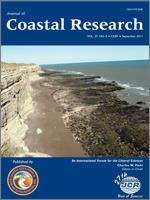Coastal areas of ecological importance, like tidal flats and salt marshes, are gradually decreasing because of large-scale coastal development projects, land reclamation, and so on. The Nakdong estuary is the most developed estuary in South Korea. The development of artificial tidal flats and salt marshes has been promoted as mitigation countermeasures. Previous studies evaluated artificial tidal flats and salt marshes for their degree of restoration of natural sites. In this paper, an in situ pilot plant of a tidal flat and a salt marsh was conducted to monitor and quantify bio-chemical indicators (biodiversity, population, and biomass of macro benthos; survival ratio of reeds; number of heterotrophic bacteria) and physicochemical characteristics. The content of dredged soil was varied to assess the difference and similarity between the natural and dredged soil. The degree of restoration and creation of ecological environmental zones is evaluated quantitatively with the use of a restoration index. The utility of this restoration index and the beneficial use of dredged soil are demonstrated for this pilot plant.
How to translate text using browser tools
1 September 2011
Ecological Restoration Index for Evaluation of Artificial Salt Marsh
Incheol Lee,
Soyoung Park,
Sunghoon Ryu,
Nobuhisa Kobayashi
ACCESS THE FULL ARTICLE

Journal of Coastal Research
Vol. 27 • No. 5
September 2011
Vol. 27 • No. 5
September 2011
dredged soil
in situ pilot plant
monitoring
Nakdong Estuary
Tidal flat
vegetation




